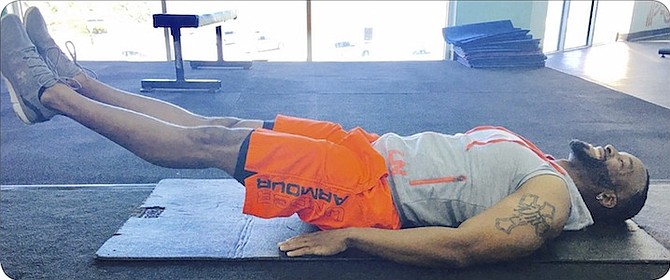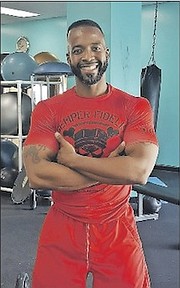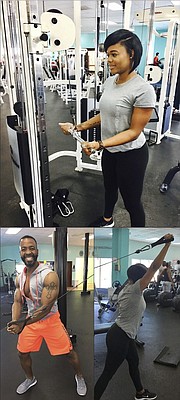By RAY FERGUSON
Personal trainer Club One
Many women suffer from the “double wave back syndrome” - you know, long after your hand has stopped moving the little jiggle of fat underneath your arm is still saying ‘farewell’.
For men, it is those nagging ‘love handles’ that seem to have become stalkers.
Well, ultimately, fat loss will play a significant role in managing these troublesome areas, but as long as you are calorie-conscious, I have a few exercises that if done correctly and consistently, along with a sensible meal plan, can and will help to not only reduce the size of but maybe even add some muscle to those fat zones.
First, let’s get a little more specific and gain a better understanding of the muscle that comprises those areas. Women will need to tighten up those triceps muscles, the muscles behind the arm which are responsible for extension and fixation of the arm at the elbow joint. It is called the triceps muscle because it is composed of three heads; the long, lateral and medial head of the triceps. The long head runs down the back of your arm and is the largest of the three heads. It is often called the inner head. The medial is positioned on the midline of the triceps, deep within the arm. The lateral head is located outside the arm, and gives the triceps its horse shoe shape.
The secret is to start with the long head. Train that first and work down so as to place the most intensity on the primary head that is responsible for the overall look and shape of the triceps. When you train the long head, the other two will either be partially or fully stimulated; even so it’s more efficient to train the primary head first.
Please do not misconstrue what I am saying and believe that somehow fat will magically turn into muscle. One cannot be converted to the other. The body can only lose or gain muscle and lose or gain fat.
Here are three distinct exercises that will aid in trimming some of the fat by building a little of muscle. The good news is that if you try these in the gym along with a sensible diet and well-structured cardio programme, you can indeed lose fat and gain muscle in the process.
One-arm overhead
cable extensions
A great option to target the long head because they will keep the triceps under constant tension throughout the entire movement while also working each arm independently to prevent any muscular imbalance.
Performing push-downs
A classic triceps exercise that targets the lateral head. Attach a straight or lateral bar to a high-cable machine. Grip the bar in your palms with your hands close together and then pull the bar down a bit. In the starting position, your elbows should be tight to your sides and bent, so that your hands are in front of your upper chest with your palms facing forward. Pull the bar down as far as possible, moving just your forearms; keep your elbows in place. Return slowly to the starting position.
Reverse grip push-down
For the medial head. Grasp the bar with an underhand grip, and keep your elbows close to your sides. Do not lean forward, focus on keeping a straight posture. Press the bar down until the arm is fully extended.
Now for those male trouble spots.
Men tend to not only get a big stomach from eating but it appears that even with some significant weight loss those darn love handles seem to get wider. Well, obviously more weight loss is needed, but nonetheless we can target and train the external oblique muscles or sides of the stomach and the psoas-major muscle (or what people wrongfully term the lower abs).
There are no upper or lower abdominal muscles, at least not anatomically speaking. The rectus abdominis comprises the entire superficial frontal layer of the abdomen region. However the psoas major is the muscle that joins the upper and lower body and as a part of the iliopsoas (iliacus and psoas-major) is one of the muscles responsible for hip flexion, or the movement of the hip during the act of sitting down. The “leg lower” exercise is great to train this body part.
Leg lower
Lie face up on a mat, with legs extended and the arms on the floor beneath the hips (lower back support) or to the side. Contract the abdominal and raise both legs to approximately a 45 degree angle, and then slowly lower them back toward the floor. Keep lower back on the floor during the entire movement. Do not lower the legs past the point where the back begins to lift off the floor. Repeat for desired number of repetitions.
One of the functions of the external oblique is to help rotate the trunk; therefore the logical approach to train this muscle would be to perform trunk rotations.
Cable high-low woodchop
Grasp the end of any attachment on a cable machine and position your body so that your right side faces the machine with knees slightly bent. Extend your arms as far as comfortably possible across your body to the right. Keeping your lower body stable, pull the cable extension across your torso to the left in a wood chopping motion. After desired number of repetitions repeat on opposite side.
• Ray Ferguson is an ACE Certified Personal Trainer, ISSA Certified Strength and Conditioning Specialist, Tabata training, Ashtanga Vinyasa Yoga and TRX Certified.







Comments
Use the comment form below to begin a discussion about this content.
Sign in to comment
Or login with:
OpenID